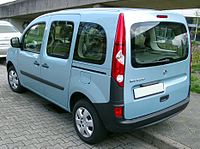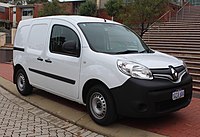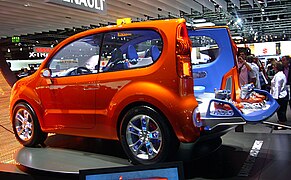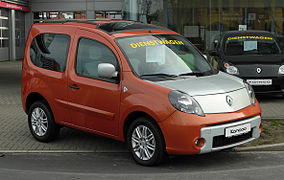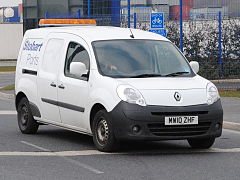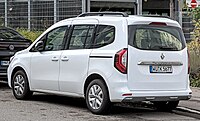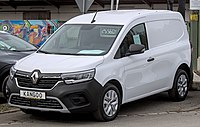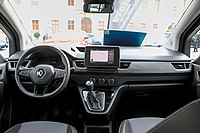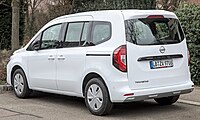The Renault Kangoo is a family of vans built by Renault since 1997 across three generations. It is sold as a passenger multi-purpose vehicle or as a light commercial vehicle. For the European market, the Kangoo is manufactured at the MCA plant in Maubeuge, France.
| Renault Kangoo | |
|---|---|
 | |
| Overview | |
| Manufacturer | Renault |
| Production | 1997–present |
| Body and chassis | |
| Class | Multi-purpose vehicle/Light commercial vehicle (M) |
| Body style | 4/5-door van |
| Layout | Front-engine, front-wheel drive Front-engine, four-wheel drive (2001–present) |
| Chronology | |
| Predecessor | Renault Express |
The Kangoo was also marketed as a rebadged variant by Nissan in Europe as the Nissan Kubistar (first generation), Nissan NV250 (second generation) and Nissan Townstar (third generation). In September 2012, Mercedes-Benz began marketing a rebadged variant of the second generation Kangoo as the Mercedes-Benz Citan, which is also marketed as Mercedes EQT and Mercedes T-Class for the current generation.[1]
As of December 2019[update], the electric variant, the Renault Kangoo Z.E., is Europe's top selling all-electric light commercial vehicle, with global sales of 48,821 units since its inception in 2011.[2]
First generation X76 (FC/KC; 1997)
| First generation | |
|---|---|
 | |
| Overview | |
| Also called | Nissan Kubistar Elect'road |
| Production | |
| Assembly |
|
| Body and chassis | |
| Body style | 4/5-door van 5-door LAV |
| Related | Renault Clio II (X65) |
| Powertrain | |
| Engine | |
| Electric motor | Permanent-magnet brushless DC motors |
| Transmission | 5-speed Manual 4-speed Automatic |
| Hybrid drivetrain | PHEV (Elect'road) |
| Battery | 13.2 kWh Ni-Cd |
| Dimensions | |
| Wheelbase | 2,605 mm (102.6 in) |
| Length | 4,035 mm (158.9 in) |
| Width | 1,670 mm (65.7 in) |
| Height | 1,800 mm (70.9 in) |
| Chronology | |
| Successor | Nissan NV200 (for Nissan Kubistar) Renault Kangoo II (Argentina) |
The first-generation Kangoo was introduced in October 1997, and was facelifted in March 2003, with new front end nose styling, especially the grille, standardised across the Renault range, with the Renault diamond mounted on a body colour panel in the centre of the grille and teardrop headlamps.
The rear windows and seats of the Kangoo could be removed, producing the panel van Kangoo Express. The Kangoo became popular with mobility-impaired people and wheelchair users due to its height and accessibility and because it could be adapted to include mounting points for wheelchairs. The rear of the vehicle is cut to allow a ramp to be fitted. A pair of front tie downs are fitted (retractable seat belts with a solenoid release to allow them to be extended, passed around the wheelchair frame and then locked back when the solenoid is switched off and they retract); this stops the wheelchair from moving back. A pair of rear tie downs with the normal clamping buckles stop the wheelchair from moving forward. A normal, long seat belt is worn by the wheelchair user.
Both the Kangoo and Kangoo Express were available in four-wheel drive versions. A lengthened version was also available, with an increased cargo area. A pickup version was sold in the Swedish market. In some countries, such as Malaysia, the Kangoo was assembled by Nissan with third row seats.
From July 2003, Wallace and Gromit starred in adverts in the United Kingdom for the Kangoo.[9]
- Kangoo (pre-facelift)
- Kangoo (first facelift)
- Rear view
- Grand Kangoo
- Kangoo (second facelift)
- Rear view
Break'Up
The Kangoo Break'Up was a four-wheel drive concept car announced in August 2002 and previewed the facelift design due in 2003, together with a pick up-style rear. It was powered by a 1.6 L engine producing 82 kW (110 hp).[10]
Kangoo Trekka 4x4

The 4WD version of the Kangoo was introduced in 2002, and was marketed under the model name Trekka.[11] It should not be confused with the Skoda-powered New Zealand-built utility vehicle named Trekka, which was marketed in the Antipodes for several years circa 1970.
The Kangoo Trekka's all-wheel drive system differed from the Renault Scénic RX4 in its inclusion of a Nissan-sourced automatic torque coupling "ATC", a hydraulic coupling that would engage drive on all four wheels should the front wheels start to lose traction.
This allowed the Kangoo Trekka to run in front-wheel drive in most conditions, thus saving fuel. Working in combination with the ATC, the Kangoo Trekka featured an electronically controlled "ASR" traction control system which could brake the front wheels to arrest traction loss.
The suspension on the front had longer front struts with revised coil springs, lower suspension arms were revised to a cast steel item. The rear suspension was completely revised from the standard Kangoo torsion bar suspension beam axle to a fully independent coil-sprung system with wishbones. The rear differential was centrally mounted with two driveshafts transmitting power to the rear wheels. All this was carried on a subframe which increased the ground clearance and wheel travel.
These changes gave the Kangoo Trekka a 400 mm (15.7 in) fording depth and 28 degree hill climbing capability. The Kangoo Trekka was marketed in the UK with a choice of two engines, the 1.6 L 16 valve petrol engine and the 1.9 L dCi common rail turbodiesel, both with a five speed manual gearbox.
In 2005, these models were priced at £12,600 and £13,600 respectively. The diesel produced a peak torque of 180 N⋅m (133 lb⋅ft) and achieved over 7 L/100 km (40 mpg‑imp; 34 mpg‑US) on the combined (urban and extra urban) fuel consumption test.
The petrol engine had a 0 to 100 km/h (0 to 60 mph) time of 14.3 seconds, and a combined fuel consumption of 9 L/100 km (31 mpg‑imp; 26 mpg‑US). The interior of the Kangoo Trekka was spartan. The rear bench seat could be folded forward to provide a 2.5 m3 (88 cu ft) loading area, with better access through the sliding side doors.
Argentina

The first-generation Kangoo was produced in Argentina from 1998 to 2018. The panel van production was launched in 1998, and the passenger model in 2001. It received a first facelift in 2008.[12] A second facelift internally codenamed VLL ("Very Long Life") was unveiled in 2013 exclusively for the Argentine market, featuring styling cues from Renault's then-current design language.[13] It was discontinued in 2018 to make way for its replacement, based on the Dokker, after 374 591 units had been produced in Argentina for the local market, and some other Latin America countries (Brazil, Uruguay, Paraguay, Colombia, Chile, Mexico and Cuba).[14]
Engines
The Kangoo and Kangoo Express was/is available with a choice of multiple engines:
| Model | Power | Type | Years |
|---|---|---|---|
| 1.0 L D Series petrol | 44 kW (59 hp) (8v) / 51 kW (68 hp) (16v) | ||
| 1.2 L D Series petrol | 45 kW (60 hp) (8v) / 56 kW (75 hp) (16v) | ||
| 1.4 L 8v Energy petrol | 56 kW (75 hp) | 1997–2003 | |
| 1.6 L 16v K Series petrol | 71 kW (95 hp) | ||
| 1.5 L dCi turbo-diesel | 43 kW (57 hp) / 48 kW (65 hp) / 51 kW (68 hp) / 52 kW (70 hp) / 61 kW (82 hp) / 63 kW (85 hp) / 66 kW (88 hp) | 2002–2009 | |
| 1.9 L F Series D diesel | 41 kW (55 hp) / 48 kW (65 hp) | normally aspirated, indirect injection | 1997–2003 |
| 1.9 L F Series dTi turbodiesel | 60 kW (80 hp) | direct injection | 1997–2003 |
| 1.9 L F Series dCi turbodiesel | 60 kW (80 hp) / 63 kW (85 hp) | 1997–2003 | |
| Electri'cité (limited edition) | battery electric | 2003 | |
| Elect'road (limited edition) | plug-in hybrid | 2003 |
Some LPG and CNG variants of petrol engines have also been produced.
Nissan Kubistar
A badge-engineered version of the Kangoo panel van was sold as the Nissan Kubistar in many European markets from 2003 to 2009.[15] Nissan applied the "X76" model code to the Kubistar.
- Front view
- Rear view
Electric
Cleanova II is a hybrid electric drive train system, used in a vehicle based on Renault Kangoo, with two electric versions: full electric vehicle (FEV) and plug-in hybrid vehicle (PHEV).[16]
Second generation X61 (FW/KW; 2007)
| Second generation | |
|---|---|
 | |
| Overview | |
| Also called | Nissan NV250 (2019–2021) |
| Production | 2007–2021 |
| Assembly | France: Maubeuge (MCA)[17] |
| Body and chassis | |
| Body style | 3/5-door panel van 5-door LAV |
| Platform | Renault–Nissan C platform |
| Related | Renault Mégane II Renault Scénic II |
| Powertrain | |
| Engine | |
| Dimensions | |
| Wheelbase | 2,313 mm (91.1 in) (Compact) 2,679 mm (105.5 in) (Express) 3,081 mm (121.3 in) (Maxi) |
| Length | 3,898 mm (153.5 in) (Compact) 4,213 mm (165.9 in) (Express) 4,666 mm (183.7 in) (Maxi) |
| Width | 1,829 mm (72.0 in) |
| Height | 1,812 mm (71.3 in) (Compact) 1,844 mm (72.6 in) (Express) 1,836 mm (72.3 in) (Maxi) |
| Chronology | |
| Predecessor | Nissan NV200/Evalia (for NV250) |
The second-generation Kangoo are based on the Scénic and manufactured in Maubeuge. Sales began in May 2007. A seven-seat version, which is longer by 40 cm, became available from July 2012.
They are also sold by Mercedes-Benz as the Mercedes-Benz Citan, with a revised front design, being launched in September 2012. In February 2012, Renault retired the Kangoo MPV, Espace, Laguna, Modus, and Wind lines in the United Kingdom.[18]
A facelifted version of both the van and the passenger versions was available from the beginning of 2013.[19][20]
In November 2018, it was announced that Nissan would rebadge the Kangoo, turning it into the NV250.[21] The Nissan NV250 launched in December 2019 and is currently sold in the United Kingdom.[22]
Body styles
The Kangoo is available in three wheelbase configurations: the Kangoo Express, the Kangoo Compact with a shorter wheelbase, and the Kangoo Express Maxi with a longer wheelbase – all three offered in passenger variants.[23][24][25] The short wheelbase version was sold as the Kangoo Be Bop between 2009 and 2012.[26]
The payload of the Kangoo Express and Express Maxi is between 650 kg (1,433 lb) and 825 kg (1,819 lb) depending on version and market, while the Kangoo Compact with its short wheelbase has a reduced payload of 500 kg (1,102 lb).[25][27] The Kangoo Express Maxi has up to 2.90 m (9.5 ft) of usable floor length.[28]
- Rear view
- Renault Kangoo (facelift)
- Renault Kangoo (facelift)
- Nissan NV250
- Rear view
Kangoo Be Bop
Following the 2007 Renault Kangoo Compact Concept, the Renault Kangoo Be Bop was presented at 2008 Paris Motor Show. This 3,870 mm (152 in) long model, with only three doors, is equipped with a sliding glass roof at the rear, 4 seats and a two-tone body.[29] Judged expensive and unpractical, the Kangoo Be Bop was a commercial failure, and only 1,400 units were produced between 2009 and 2011.[30][31]
- Renault Kangoo Compact Concept
- Renault Kangoo Be Bop
Kangoo Express Compact
Kangoo Express
Kangoo Express Maxi
Grand Kangoo

A 7-seater version of the Kangoo, named Grand Kangoo, has been on the market since July 2012.[32]
Engines
Kangoo Z.E.
| Kangoo II Z.E. / E.Tech electric | |
|---|---|
 | |
| Overview | |
| Production | 2011–2021 |
| Assembly | France: Maubeuge (MCA) |
| Body and chassis | |
| Class | Electric panel van |
| Body style | Van |
| Powertrain | |
| Electric motor | 44 kW (59 hp), 226 N⋅m (167 lb⋅ft) AC synchronous motor |
| Battery | 22 kWh lithium ion battery[33] |
| Range | 170 km (110 mi) NEDC[33] |
| Dimensions | |
| Wheelbase | 2,697 mm |
| Length | 4,282 mm |
| Curb weight | 1,410 kg (3,110 lb) |
- History
As part of its Z.E. electric car initiative, Renault has developed the Kangoo Z.E. model that is manufactured at its Maubeuge plant.[34] A prototype was shown at the September 2010 International Commercial Vehicles Show in Hanover, Germany,[35] and the electric van was released for retail sales in October 2011.[36] In November 2011, the Kangoo Z.E. was voted International Van of the Year for 2012.[37][38] It was also elected Electric Vehicle of the Year in 2012 and 2013 by GreenFleet.[39]
It was introduced to Mexico on 15 October 2020.[40] In 2021, the next-generation electric Kangoo was introduced as the Kangoo E-Tech electric, based on the Renault–Nissan CMF-C/D platform.[41]
- Sales
A total of 3,652 Kangoo Z.E. utility vans were registered in France through December 2012,[42][43] and, with 2,869 units delivered in 2012, the electric van became the top selling plug-in electric vehicle in the country.[43] During 2011, the Kangoo Z.E. sold 991 units in Europe, and cumulative sales in the region reached 6,658 units sold in the region through December 2012, with global sales of 6,665 units.[44]
Worldwide cumulative sales passed the 10,000 mark by the start of September 2013, representing about 10% of overall Kangoo van global sales.[45] The Kangoo Z.E. is the leader of the small all electric van segment, and the best selling electric vehicle in France, with 9,125 units registered through June 2014.[42][43][46][47] The vehicle was updated in 2017.
The Kangoo Z.E. is Europe's top-selling all-electric light commercial vehicle, with global sales of 48,821 units since its inception through December 2019.[2]
- Drivetrain
The Kangoo Z.E. has the same dimensions as the internal combustion model. It uses a synchronous electric motor with rotor coil. Its peak power is 44 kW (59 hp) at 10,500 rpm, while maximum torque is 226 N⋅m (167 lbf⋅ft). Its top speed is capped electronically to 130 km/h (81 mph).[35][48] The vehicle is powered by a 22 kWh lithium-ion battery pack that delivers a combined cycle range of 170 km (110 mi) NEDC which varies depending on factors such as type of road, ambient temperature, speed or driving style.[33] Maximum charging power is limited to 3.7 kW (AC).[49]
The Kangoo Z.E. Power+, released in 2017, includes four changes: a new battery, a new motor, a new charger, and a heat pump. The new battery has a capacity of 33 kWh for a range of 270 km (170 mi) according to the NEDC cycle.[50] The new R60 traction motor produces the same peak power 44 kW (59 hp), but was developed by Renault, based on the R90 motor found in Renault Zoe. Charging power has doubled to 7 kW, and the heat pump provides a more efficient method of heating the cabin.[51]
Third generation XFK (FFK/KFK; 2020)
| Third generation | |
|---|---|
 | |
| Overview | |
| Also called | Mercedes-Benz Citan/T-Class/EQT Nissan Townstar/Townstar Evalia[52] |
| Production | 2020–present |
| Assembly | France: Maubeuge (ElectriCity Maubeuge Plant)[17] |
| Body and chassis | |
| Body style | 3/5-door panel van 5-door LAV |
| Platform | Renault–Nissan CMF-CD platform[53] |
| Powertrain | |
| Engine | |
| Transmission | 6-speed manual 7-speed EDC |
| Dimensions | |
| Wheelbase | 2,716 mm (106.9 in) |
| Length | 4,486 mm (176.6 in) |
| Width | 1,919 mm (75.6 in) |
| Height | 1,838 mm (72.4 in) |
| Curb weight | 1,475–1,688 kg (3,252–3,721 lb) |
| Chronology | |
| Predecessor | Nissan e-NV200 (for Townstar EV) |
The third-generation Kangoo was revealed on 12 November 2020, alongside the lower-spec, separate model called Express.[54] It is based on an all-new CMF-CD platform developed by Renault and Nissan. Production started late 2020[55] and sales early 2021.[56]
A rebadged version[57] called the Nissan Townstar was revealed in September 2021 to replace the NV200[58] and NV250 in various markets. In Europe, the electric Nissan e-NV200 will be replaced by a Townstar EV based on the Kangoo E-Tech Electric.
- Rear view
- Renault Kangoo van
- Renault Kangoo van
- Interior
- Nissan Townstar
- Nissan Townstar
Engines
| Model | Engine | Displacement | Valvetrain | Fuel system | Max. power at rpm | Max. torque at rpm | Gearbox | Years | Consumption | CO 2 |
|---|---|---|---|---|---|---|---|---|---|---|
| Petrol engines | ||||||||||
| TCe 100 | Nissan H5Ht | 1,333 cc | DOHC 16v | Direct injection | 100 hp (75 kW; 100 PS) @ 4,500 rpm | 200 N⋅m (148 lb⋅ft) @ 1,500 rpm | 6 speed manual | 2021–present | 41.5 mpg‑imp (6.81 L/100 km) | 155 g/mi (96 g/km) |
| Diesel engines | ||||||||||
| Blue dCi 95 | Renault K9K | 1,461 cc | SOHC 8v | Common rail direct injection | 95 hp (71 kW; 96 PS) @ 3,750 rpm | 260 N⋅m (192 lb⋅ft) @ 1,750 rpm | 6 speed manual | 2021–present | 53.3 mpg‑imp (5.30 L/100 km) | 139 g/mi (86 g/km) |
| Blue dCi 115 EDC | Renault K9K | 1,461 cc | SOHC 8v | Common rail direct injection | 115 hp (86 kW; 117 PS) @ 3,750 rpm | 270 N⋅m (199 lb⋅ft) @ 1,750 rpm | 7 speed automatic | 2021–present | 50.4 mpg‑imp (5.60 L/100 km) | 147 g/mi (91 g/km) |
| Model | Charger | Battery | Range | Motor | Max. power at rpm | Max. torque at rpm | Gearbox | Years | Consumption | CO 2 |
| Electric | ||||||||||
| E-Tech |
|
Li-ion, 44 kW-hr (net) | 186 mi (299 km) (WLTP) | synchronous with coiled rotor | 120 / 60 hp (89 / 45 kW; 122 / 61 PS) Normal/Eco | 245 N⋅m (181 lb⋅ft) | Single-speed reduction gear | 2021–present | – | 0 g/mi (0 g/km) |
Dimensions
Length Height |
L1 | L2 | ||||
|---|---|---|---|---|---|---|
| Exterior | 4,486 mm (176.6 in) | 4,910 mm (193.3 in) | ||||
| WB | 2,716 mm (106.9 in) | 3,100 mm (122.0 in) | ||||
| Interior | 1,806 mm (71.1 in) | 2,230 mm (87.8 in) | ||||
| H1 | Exterior | Interior | Volume | 3.3 m3 (120 cu ft) | 4.2 m3 (150 cu ft) | |
| 1,864 mm (73.4 in) | 1,215 mm (47.8 in) | |||||
- Notes
- Interior width is 1,570 mm (61.8 in) for all versions, 1,248 mm (49.1 in) between the internal wheel arches.
Kangoo E-Tech Electric

The third generation Renault Kangoo was previewed by the Renault Kangoo Z.E. concept presented on 23 April 2019, which was said to be 80% representative of the production model.[60] The Kangoo Z.E. concept (2019) is an electric vehicle and has no pillar at the leading edge of the sliding side door to facilitate access, like the Frendzy concept.[61] A prototype of the production electric Kangoo, renamed to Kangoo Van E-Tech Electric, was first shown in March 2021.[62] It was officially introduced in November 2021 to succeed the prior electric Kangoo Z.E., which was based on the second-generation Kangoo and had been produced since 2011. Production was scheduled to start in 2022.[63]

The 100% electric production panel van model entered production in June 2022. It is offered in two lengths, with cargo volume of 3.9 m3 (140 cu ft) or 4.9 m3 (170 cu ft).[63] The passenger version was launched in October 2022[64] at the 2022 Paris Motor Show.[65]
The Kangoo E-Tech is equipped with a traction motor that delivers 90 kW (120 hp) and 245 N⋅m (181 lbf⋅ft), drawing from a 45 kW-hr battery which gives the vehicle an estimated range of 285–300 km (177–186 mi) under the WLTP mixed driving cycle.[64] So equipped, the van accelerates from 0 to 100 km/h (0 to 62 mph) in 11.6 seconds and has a top speed of 135 km/h (84 mph).[66] There is a limited-power Eco mode, which reduces output to 56 kW (75 hp) and maximum speed to 110 km/h (68 mph). The standard onboard charger is limited to 11 kW (AC); as an option, the vehicle can be fitted with a charger that allows input power up to 80 kW (DC) or 22 kW (AC).[64]
Safety
Euro NCAP
The Kangoo in its standard European market configuration received 4 stars from Euro NCAP in 2021.[67]
The Townstar in its standard European market configuration received 4 stars from Euro NCAP in 2021.[68][69]
Production
Nissan NV200
Third-generation model
References
External links
Wikiwand in your browser!
Seamless Wikipedia browsing. On steroids.
Every time you click a link to Wikipedia, Wiktionary or Wikiquote in your browser's search results, it will show the modern Wikiwand interface.
Wikiwand extension is a five stars, simple, with minimum permission required to keep your browsing private, safe and transparent.








